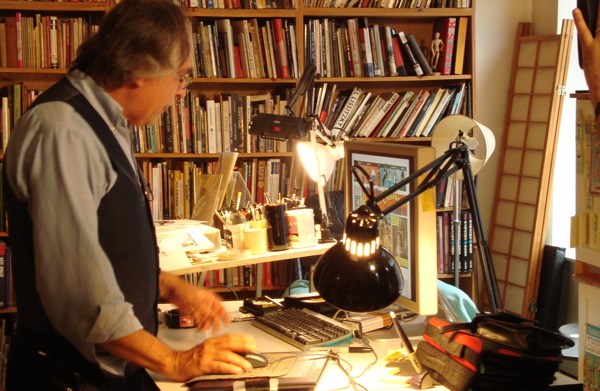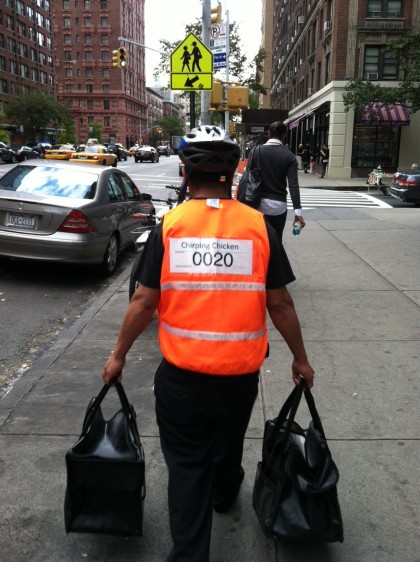By Nancy Novick
The Art of Spiegelman
Early in the documentary about his work, artist Art Spiegelman lets us know that he isn’t very productive when he’s feeling good, for example, when he’s just had sex. Disaster is his self- proclaimed muse and sadly there is much in his personal history for him to mine including his mother’s suicide, his father’s stories of the Holocaust—famously retold in Maus and Maus II, his struggles with depression, and his traumatic experience of 9/11 while living and working in Soho.
 In spite of the deeply sad aspects of Spiegelman’s work, Clara Kuperberg and Joelle Oosterlinck’s The Art of Spiegelman is a very entertaining and ultimately uplifting film. Mr. Spiegelman is funny and intelligent, thoughtful and honest. As the viewer seated beside me noted, he is also charming. He is frank about the pleasures and difficulties of success, the depression that followed his new-found celebrity after the publication of Maus and receiving the Pullitzer Prize (1992), and his ongoing anxiety about when, or even whether, he will get his next idea.
In spite of the deeply sad aspects of Spiegelman’s work, Clara Kuperberg and Joelle Oosterlinck’s The Art of Spiegelman is a very entertaining and ultimately uplifting film. Mr. Spiegelman is funny and intelligent, thoughtful and honest. As the viewer seated beside me noted, he is also charming. He is frank about the pleasures and difficulties of success, the depression that followed his new-found celebrity after the publication of Maus and receiving the Pullitzer Prize (1992), and his ongoing anxiety about when, or even whether, he will get his next idea.
The film also takes us through Mr. Spiegelman’s childhood and his discovery of Mad magazine which “taught him to be subversive” and about the “world beyond his parents”; his early years in San Francisco; the creation of Raw, an underground comics magazine with his wife, Francois Mouly; his 10 years at the New Yorker magazine creating memorable cover art, including the black on black depiction of the twin towers and the controversial depiction of a Chasidic man kissing an African- American woman, published after the Crown Heights riots. We are afforded a brief glimpse of what appears to be warm relationship with his children and a look at what’s next for the artist, a return to comics for children.
At the conclusion of the film (which seems destined for wider distribution), Spiegelman recalls the time when adults first acknowledged that comics weren’t “just for children.” Now, he says, it may be time to remember that they are “not just for adults.”
Note: A retrospective exhibit of Mr. Spiegelman’s work will be on view at the Jewish Museum later this year.
*****
The Art of Spiegelman is being screened with Castaway, a 17-minute film by Slawomir Grunberg and Tomasz Wisniewsk. Based on interviews with residents of Lapy, Poland a small town in the northeastern part of the country, Castaway tells the heartbreaking story of Jews bound for Treblinka, who threw their children from the trains as they passed through the town in a desperate attempt to save them. The men and women who witnessed these events, now in their 80s and 90s, tell their stories simply and movingly. While most of the Jewish children were killed almost immediately by Nazi soldiers, at least one survivor was taken in by a Polish Catholic family and still lives in Lapy.
*****
Cabaret-Berlin: The Wild Scene
Cabaret-Berlin: The Wild Scene is not a documentary in the usual sense of the word. Instead, director Fabienne Rousso-Lenoir has conceived of this project as a kind of cabaret show itself, more of a performance than a story. The film, currently playing as part of the New York Jewish Film Festival offers little in the way of a descriptive narrative.
 Composed of archival film clips and recordings, the movie includes a varied series of evocative images including World War I bombers filling a crowded sky, the wounded returning home, Lotte Lenya singing, performers breaking the fourth wall, and a trio singing comically of bankruptcy as their belongings are taken away one-by-one. Actor Ulrich Tukur (perhaps best known in this country for his role as a high-ranking Stasi officer in the remarkable The Lives of Others) provides a “narration” of sorts, speaking in a sometimes strident, sometimes mocking or ironic tone.
Composed of archival film clips and recordings, the movie includes a varied series of evocative images including World War I bombers filling a crowded sky, the wounded returning home, Lotte Lenya singing, performers breaking the fourth wall, and a trio singing comically of bankruptcy as their belongings are taken away one-by-one. Actor Ulrich Tukur (perhaps best known in this country for his role as a high-ranking Stasi officer in the remarkable The Lives of Others) provides a “narration” of sorts, speaking in a sometimes strident, sometimes mocking or ironic tone.
As cabaret music plays in the background and then intermittently comes into focus he alludes to the divide between rich and poor, inflation and economic collapse, the public rounding up of subversives, and the rise and fall of various political factions. It’s as if we are kaleidoscopically fast-forwarding through the years of the Weimar Republic.
Ms. Rousso-Lenoir’s intentions are heartfelt and admirable—in a Q and A period following the screening she described her wish to honor the contribution of these mostly Jewish performers to the culture of modernity and to conjure the interactive nature of cabaret. To some extent she succeeds. The film ends with still photos and names of a number of singers, writers, musicians, and composers, many of whom are not singled out until this point. With the exception of a few well- known individuals—including Marlene Dietrich, Kurt Weill, and Lotte Lenya—the faces and names are unfamiliar and their individual accomplishments largely unexplained. Ms. Rousso-Lenoir’s film offers a wealth of impressions, but the viewer with only a slight knowledge of cabaret culture in Berlin is left wanting to know more.
The New York Jewish Film Festival continues through Thursday, January 24. For a schedule of the remaining screenings, go to https://www.filmlinc.com/films/series/new-york-jewish-film-festival-2013
Nancy Novick blogs about books, bookstores, and libraries at www.Stacked-NYC.com.










I was at this screening and found these reviews insightful.